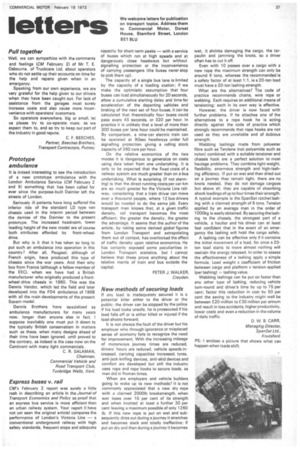New methods of securing loads
Page 39

If you've noticed an error in this article please click here to report it so we can fix it.
If any load is inadequately secured it is a potential killer either to the driver or the public; the driver can be stopped by the police if his load looks unsafe. he is prosecuted if his load falls off or is either killed or injured if the load shoots forward.
It is not always the fault of the driver but his employer who through ignorance or misplaced sense of economy fails to recognize the need for improvement. With the increasing mileage of motorways journey times are reduced, drivers' hours are reduced, vehicle speeds increased, carrying capacities increased, tyres, anti-jack-knifing devices, anti-skid devices and comfort are developed but still the industry uses rope and rope hooks to secure loads, as men did in Roman times.
When are employers and vehicle builders going to wake up to new methods? It is not commonly appreciated that a new dry rope with a claimed 200016 breakstrength, when wet loses over 10 per cent of its strength and when knotted at least a further 30 per cent leaving a maximum possible of only 1260 lb. If this new rope is put on wet and subsequently dries out during a journey it stretches and becomes slack and totally ineffective; if put on dry and then during a journey it becomes wet, it shrinks damaging the cargo, the tarpaulin and jamming the knots, so a driver often has to cut it off.
Even with 10 passes over a cargo with a new rope the maximum strength can only be around 6 tons, whereas the recommended is a safety factor of at least 11. ie a 20-ton load must have a 20-ton lashing strength.
What are the alternatives? The code of practice recommends chains, wire rope or webbing. Each requires an additional means of tensioning; each in its own way is effective.
However, the driver is now faced with further problems. If he attaches one of the alternatives to a rope book he is acting directly against the code of practice which strongly recommends that rope hooks are not used as they are unreliable and of dubious strength.
Webbing lashings made from polyester fibre such as Terylene (not polyamide such as nylon) combined with a suitable tensioner and chassis hook are a perfect solution to most haulage problems. They combine light weight, flexibility, enormous strength and high-lashing efficiency. If put on wet and then dried out on a journey they remain tight, there are no • knots needed, they do not damage cargoes but above all, they are capable of absorbing shock loadings of up to four times their strength. A typical example is the SpanSet ratchet lashing with a claimed strength of 8 tons. Tension applied by an average man in the order of 1000kg is easily obtained. By securing the lashing to the chassis, the strongest part of a vehicle, a haulier and his driver can at least feel confident that in the event of an emergency the lashing will hold the cargo safely.
A lashing can be effective only if it contains the initial movement of a load, for once a 20ton load starts to move almost nothing will restrain the energy released. In order to assess the effectiveness of a lashing apply a simple formula. Load weight x coefficient of friction between cargo and platform x tension applied (per lashing) — lashing value.
Webbing lashings can be put on faster than any other type of lashing, reducing vehicle turn-round and driver's time by up to 75 per cent; factor this reduction in cost by 50 per cent the saving to the industry might well be between £20 million to £30 million per annum and result in less accidents, higher productivity, lower costs and even a reduction in the volume of daily traffic.
D. W. B. CARR, Managing Director, SpanSet Ltd., Knots ford. PS: I enclose a picture that shows what can happen when loads shift.












































































































